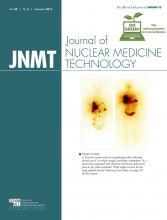Norman E. Bolus, MSPH, MPH, CNMT, FSNMMI-TS
I am pleased to announce to the JNMT readership that 2 new features have been achieved that have been long-term goals for JNMT. The first goal is that, starting in June of this year, reviewers for JNMT now may get between 0.5 to 1.5 continuing education units (CEUs) for completing a peer review. The number of units will be at the discretion of the Editor, but the full 1.5 CEUs will be given for the most complex reviews. The only barrier once CEUs are requested by a reviewer is that the review must be completed within 2 weeks of acceptance of the review or the BenchPress/HighWire system will automatically disqualify the reviewer from receiving CEU credit. This provides an incentive to complete reviews on time as well as a thank-you for reviewing. This feature has been in the works for many years and actually goes back before the time I began as editor. If you would like to be a reviewer for JNMT, you must set up an account on the JNMT website (http://submit-tech.snmjournals.org). I would consider anyone with at least 5 years of experience in the field as a technologist, scientist, physician, or educator eligible to be considered as a reviewer. You can list which expert areas you feel comfortable reviewing, and there are many resources available on the reviewer website to learn how to complete a good review. For me, this is a huge achievement, as reviewers for the JNM have had this possible benefit in the past whereas JNMT reviewers have not. Just a reminder: if you have been a reviewer in the past, you must maintain an updated e-mail address to be contacted, and the JNMT website does not share information with the SNMMI website. If you update your e-mail with SNMMI, it will not automatically be updated with JNMT; to remain an active reviewer, you must log on to the JNMT website and update your e-mail address there as well.
The second new development for JNMT is that all past journals are now available as archived documents via .pdf format. This new feature for the JNMT is another major achievement that has been in the works for many years. The March 1973 through September 2000 editions are available (http://tech.snmjournals.org/content/by/year) in .pdf format only, whereas articles from 2000 to the present are available in multiple formats. This is a huge advantage for the historical preservation of JNMT. I commend the SNMMI staff for continuing to pursue this effort over time. Having a digital retrieval capability for JNMT brings us again in line with a feature that JNM has had for many years and is expected for professional journals in this digital age.“You never know what’s around the corner. It could be everything. Or it could be nothing. You keep putting one foot in front of the other, and then one day you look back and you’ve climbed a mountain.”
—Tom Hiddleston, Actor
In this edition of JNMT, there is one original continuing education article and one reprinted continuing education article. The original article is “Technical Considerations for Brain Amyloid PET Imaging with 18F-Florbetapir,” by LisaAnn Trembath, Maureen Newell, and Michael D. Devous, Sr. Many thanks go to them for submitting this article. The reprinted offering is from JNM, “Radiotracer Imaging of Peripheral Vascular Disease,” by Mitchel R. Stacy, Wunan Zhou, and Albert J. Sinusas. Just a reminder: this being a reprint, if you have previously received CEU credit for this article you cannot receive credit twice. There are 5 teaching case reports on a range of infrequently seen cases in PET imaging and general nuclear medicine imaging. There are 6 imaging articles pertaining to a range of topics. A couple of these articles look at myocardial perfusion imaging, whereas another one looks at glomerular filtration rates. There is also an article on macroaggregated albumin optimization of dose and a method to improve the accuracy of standardized update values. Please consider submitting articles, correspondence, letters to the editor, teaching case reports, CEU articles, perspectives, or commentaries to JNMT. All elements are peer-reviewed and welcomed additions to JNMT. I have also requested that all SNMMI chapters, as well as our international partners, send in a report for the December issue.
Finally, in a continuing effort to encourage online discussion, we have posted another situational judgment on the SNMMI Facebook page. Please go to www.snmmi.org/facebook and add your comments about the new situation, “What would you do if a family member asked your opinion about setting a do-not-resuscitate (DNR) order in his or her living will?”








